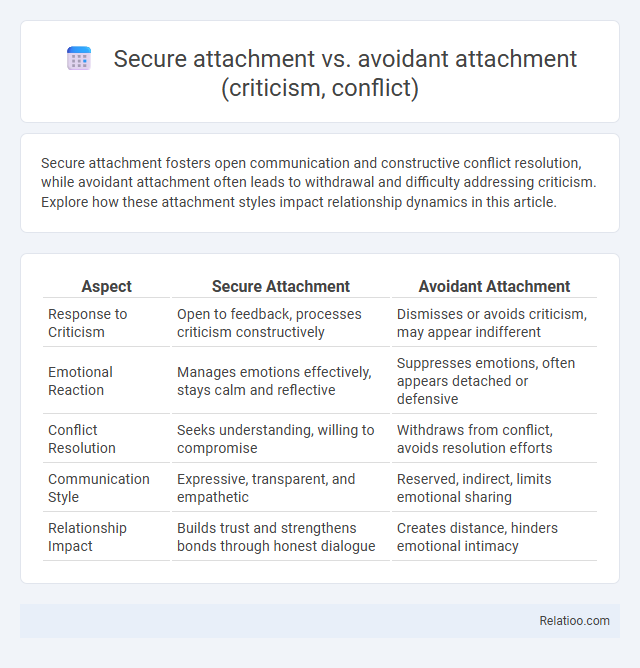Secure attachment fosters open communication and constructive conflict resolution, while avoidant attachment often leads to withdrawal and difficulty addressing criticism. Explore how these attachment styles impact relationship dynamics in this article.
Table of Comparison
| Aspect | Secure Attachment | Avoidant Attachment |
|---|---|---|
| Response to Criticism | Open to feedback, processes criticism constructively | Dismisses or avoids criticism, may appear indifferent |
| Emotional Reaction | Manages emotions effectively, stays calm and reflective | Suppresses emotions, often appears detached or defensive |
| Conflict Resolution | Seeks understanding, willing to compromise | Withdraws from conflict, avoids resolution efforts |
| Communication Style | Expressive, transparent, and empathetic | Reserved, indirect, limits emotional sharing |
| Relationship Impact | Builds trust and strengthens bonds through honest dialogue | Creates distance, hinders emotional intimacy |
Understanding Attachment Styles: Secure vs Avoidant
Secure attachment is characterized by trust and comfort in close relationships, promoting emotional openness and effective conflict resolution. Avoidant attachment often involves emotional distance and discomfort with intimacy, leading to criticism and conflict when partners seek closeness. Understanding the dynamics between secure and avoidant attachment styles helps identify patterns of behavior and improve communication strategies in relationships.
Key Features of Secure Attachment
Secure attachment is characterized by trust, emotional openness, and effective communication, fostering healthy relationship dynamics. In contrast, avoidant attachment often involves emotional distancing and suppression of feelings, leading to conflicts and misunderstandings. Key features of secure attachment include consistent responsiveness, comfort with intimacy, and balanced autonomy, which contribute to conflict resolution and relationship satisfaction.
Hallmarks of Avoidant Attachment
Avoidant attachment is marked by emotional distance, discomfort with intimacy, and a strong preference for self-reliance, often leading to challenges in expressing feelings during conflicts. In criticism conflicts, individuals with avoidant attachment may withdraw or minimize issues, making it difficult for You to engage in open communication or resolve misunderstandings effectively. Their hallmark is a protective mechanism that reduces vulnerability but can hinder relationship growth compared to secure attachment, which fosters trust, emotional availability, and healthy conflict resolution.
Emotional Regulation in Secure and Avoidant Individuals
Secure attachment fosters healthy emotional regulation by allowing individuals to express and manage feelings effectively, promoting resilience and empathy. Avoidant attachment often leads to emotional suppression or distancing, resulting in difficulties recognizing and processing emotions, which can hinder conflict resolution. Your ability to regulate emotions is stronger with secure attachment, enhancing interpersonal communication and reducing criticism-driven conflicts.
Communication Patterns During Conflict
Secure attachment manifests through open, empathetic communication during conflicts, facilitating constructive dialogue and mutual understanding. Avoidant attachment often results in emotional distancing and minimal disclosure, hindering resolution and escalating misunderstandings. In relationships where one partner is securely attached and the other avoidant, communication frequently suffers from withdrawal and frustration, making conflict resolution challenging.
Criticism in Relationships: Secure vs Avoidant Responses
Secure attachment in relationships fosters open communication and constructive responses to criticism, enabling you to address conflicts without defensiveness. Avoidant attachment tends to trigger emotional withdrawal and minimization of problems when faced with criticism, often escalating tension and unresolved issues. Understanding these patterns helps develop healthier conflict resolution strategies by promoting emotional availability and receptiveness to feedback.
How Each Attachment Style Handles Emotional Distance
Secure attachment allows you to comfortably manage emotional distance by maintaining trust and open communication, fostering closeness even during conflicts. Avoidant attachment, by contrast, tends to respond to emotional distance with withdrawal and suppression of feelings, often leading to increased misunderstanding and unresolved tension. In contrast, secure attachment actively addresses emotional gaps through empathy and validation, promoting healthier conflict resolution and relational stability.
Impact of Attachment Styles on Relationship Satisfaction
Secure attachment promotes higher relationship satisfaction through effective communication, emotional responsiveness, and trust building, fostering intimacy and conflict resolution. In contrast, avoidant attachment often leads to emotional distancing, reduced vulnerability, and difficulty managing criticism, which can increase conflicts and decrease satisfaction. The interplay between secure and avoidant attachment styles significantly impacts relationship dynamics, as secure partners may struggle to bridge the emotional gaps created by avoidant behaviors, leading to cyclical dissatisfaction.
Overcoming Challenges: Bridging the Secure-Avoidant Gap
Overcoming challenges between secure attachment and avoidant attachment requires understanding key differences in emotional expression and trust. Your ability to foster open communication and patience can bridge the gap by encouraging avoidant partners to gradually share vulnerabilities without fear of judgment. Building a secure foundation hinges on consistent reassurance and mutual respect, promoting stronger emotional bonds and reducing criticism conflicts.
Strategies for Healthy Conflict Resolution
Secure attachment promotes open communication, emotional responsiveness, and mutual respect, enabling effective conflict resolution through empathy and collaboration. Avoidant attachment often leads to withdrawal and emotional distance during conflicts, making it crucial to implement strategies like active listening, patience, and gentle encouragement to express feelings. Combining secure attachment practices with awareness of avoidant tendencies fosters healthier conflict management, emphasizing validation and gradual trust-building to resolve disagreements constructively.

Infographic: Secure attachment vs Avoidant attachment (criticism conflict)
 relatioo.com
relatioo.com